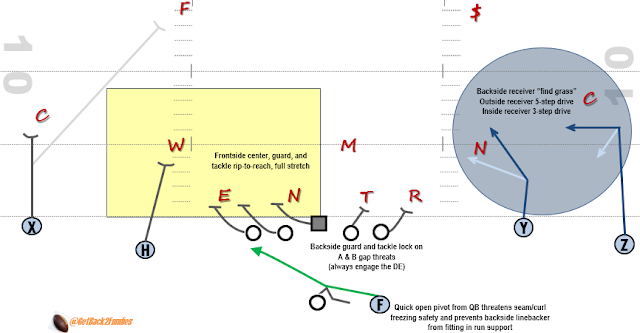Monday, 27 August 2018
2015 Offensive Trends
2015 Offensive Trends
In the past few seasons, we�ve seen spread offenses evolving at a quicker pace using no-huddle quick tempo, run-pass options, and nontraditional personnel groupings (for a spread offense) to befuddle defenses and tip the scales in their favor. Defensive coordinators have been challenged to keep up with these attacks and adapt their own philosophies to the changing times.
Even with this advantage, some offenses are doing their best to push the envelope even further to remain on the bleeding edge of efficiency. Many teams such as the Philadelphia Eagles, Ohio State Buckeyes, Baylor Bears and the Cal Bears are leading this charge.

This season, we will explore these variations, the challenges they present, and what defenses can do to swing momentum back in their court (next post).
Back in 2011, we took a look at the costs of running from the gun and the impact it had on the playbook and to defenses. The conclusion at the time was to distill it down to inside or outside zone and limit the playbook to one concept per area of attack (inside, outside, perimeter attack). Now four seasons later, offensive innovators have found a way to marry multiple concepts to get the best of many worlds.
The most popular run-pass option out there is zone-read with a backside pass. While it used to be just feature the bubble screen to stretch a backside overhang defender with the threat of a quarterback run, offenses today are looking to create as much of a vertical stretch as they are horizontal. The offensive leaders today run routes on EVERY run play so the action remains consistent to defenses.
The zone-read often gets dismissed because the prevailing opinion is that you cant be successful without a mobile quarterback. However, what weve seen (with Nick Foles success), is the play fake of the give is what is the most valuable element of the zone boot. The challenge is, if youre optioning on the backside end, the athleticism of a Mike Vick is needed to avoid getting blasted regularly from that defender of preventing the defender from chasing down the zone run from behind.
As we saw in last weeks preseason game, if the quarterback isnt actually passing, he remains a target.

...this is what happens, Larry
So what do you do when you are committed to throwing the ball, have (and recruit) throwers, but need to have a viable zone run game? How do you protect the investment of your quarterback as a weapon?
Offenses today are foregoing the post-snap end read and now pre-snap keying backside "grass" to put vital backside run-fit players on an island. These overhang defenders will be unable to commit to filling cutback lanes lest a receiver finds open grass for an easy completion. This adjustment of locking the backside end with stretch-read runs, eliminates the most dangerous rusher to the quarterback. This has the added benefit of preventing backside linemen from going too far downfield if the quarterback decides to throw and also mirrors common spread slide/man pass protection, causing more hesitation to a defenders key read.

Front side linemen are looking to reach outside "D" gap to stretch the edge of the defense like wide zone. The intent is to stretch the playside of the defense to split the defense down the middle because the backside of the defense will be occupied with pass action to the backside receivers. Blocking the backside end essentially occupies 4-5 defenders from being a factor fitting in primary gap support. Because stretch is more of a horizontal play than the vertical track of inside zone, there is no risk of frontside players being downfield if the quarterback decides to pull the ball and throw.

Watch the effect the snap pivot has on the defense

Dont respect the backside void? Pay the price
In the coming weeks, we will explore how defenses adjust to legitimate run-pass option offenses and how offense counter again. Stay tuned.
Subscribe to:
Post Comments (Atom)
No comments:
Post a Comment